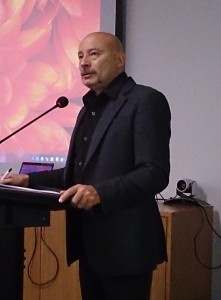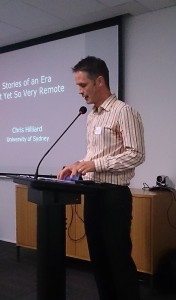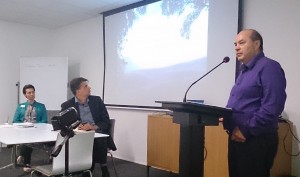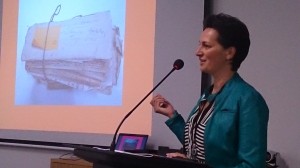Cowan Symposium. Cultural Go-Between, Colonial Man: New Perspectives on James Cowan.
A successful one-day symposium was held at the National Library on Friday 21 February, a joint event run by Annabel Cooper of the Centre for Research on Colonial Culture and Ariana Tikao of the Alexander Turnbull Library. It attracted more than 65 attendees, including academics, librarians, archivists, professional and governmental historians, and other interested people. Chief librarian of the Alexander Turnbull Library, Chris Szekely, welcomed people to the event, and suggested that it was a good start to CROCC’s relationship with the Turnbull and National Library, and hopefully the first of many events. Chris’s welcome was followed by a mihi from the Turnbull’s Curator Māori, Paul Diamond.
Chris Hilliard (University of Sydney) returned to Cowan, a subject of research earlier in his career, with the keynote address ‘Stories of an Era Not Yet So Very Remote’ in which he asked us to look beyond Cowan’s grand statements – ones with which he can so easily be tied to the colonial project – to his love of detail, and it was through these that we could get a better understanding of the man. Chris stressed Cowan’s love of New Zealand history, and his connection with place and people.
The themes that Chris set out were picked up by the three speakers who followed. Paul Meredith of Ngāti Maniapoto, like Cowan, grew up in the Kihikihi area, and values the writer’s work, in particular his oral history, as a means of unlocking the voices of his tūpuna. He pointed out too that Cowan collaborated with Raureti Te Huia and the methods they used have parallels with the kaupapa Māori methodology of today.
Te Kenehi Teira of Ngāti Raukawa, Kaihautu Māori for the Historic Places Trust, spoke about the Trust’s development of interpretation and other resources for the Ōrākau commemorations, and a smartphone driving app for the Waikato battle sites. As Te Kenehi said, the app was a means of bringing Cowan into the modern world. The researchers utilised Cowan’s writings as a means of adding detail to the interpretations, and in the case of Ōrākau, of pinpointing the actual site of the pā.
This session was closed by Ariana Tikao of Kāi Tahu, Research Librarian Māori, who discussed the Turnbulls’ recent acquisition and description of 202 folders of Cowan manuscript material (acquired at the end of 2012) that now complements the Library’s existing collection. Ariana also talked about putting together Borderland: The World of James Cowan, (running to 26 April in the Alexander Turnbull Gallery), her exhibition exploring the writer’s life, work and legacy.
After lunch, we heard from Greg Woods who talked on Cowan’s years as a journalist at the Auckland Star (1888-1903). During this time Cowan wrote at least 370 feature articles, some of which he incorporated into his later books. Cowan was a “Māori specialist” perhaps due to his language skills, and unlike most reporters of the time, was able to add his name to these articles. While also shipping reporter Cowan met some famous writers, such as Rudyard Kipling, Mark Twain and Robert Louis Stevenson, and Greg argued that Cowan took Stevenson as a sort of literary model for his writing. Kathryn Parsons, Special Collections Librarian at the University of Waikato, discussed Cowan’s later writing for children in The Enzed Junior, a weekly Saturday supplement that ran from 1934 to 1941. Cowan wrote 255 articles for this publication, 190 of which were on Māori-related topics. Staying with young people, the final speaker in this session, Jim Frood, a history teacher at Kings College, Auckland spoke on the secondary schools history curriculum and the value of Cowan’s work as a resource in the teaching of Year 11-13 history.
Roger Blackley of VUW began the last session with a discussion on Pictures of Old New Zealand, comprising Lindauer portraits of Māori men and women with bibliographical information supplied by Cowan. Roger showed how Cowan re-used text written by earlier writers, such as James Mackay, but moderating some of the sentiments for the sensibilities of his own day. Although Cowan’s writing is about the people, rather than the art itself, Roger argued that Pictures of Old New Zealand might be considered New Zealand’s first art monograph. Lydia Wevers (Stout Centre, VUW) then spoke about Cowan’s travel writing, in particular his work on the Main Trunk Line written for railway tourism purposes. This work shows Cowan’s contradictory attitudes to colonialism, on the one hand accepting the inevitable march of progress, while also lamenting the loss of the bush, and the old Māori ways of life. Annabel Cooper (University of Otago) and Diane Pivac from New Zealand Film Archive, looked at Cowan’s influence on New Zealand films of the New Zealand Wars, from Rudall Hayward (for whom he worked as an advisor) to Geoff Murphy’s Utu, which was inspired by one of Cowan’s stories, to Vincent Ward’s River Queen. We were treated to excerpts from Hayward’s Te Kooti Trail, a silent movie in which Hayward used descendants of the historical figures as actors, and his last movie, Rewi’s Last Stand. Tony Ballantyne (University of Otago and CROCC Director) wrapped up the day, reminding us that Cowan is a more complex personality than superficial reading of his work might suggest.
Cowan Symposium: Registration Closes Soon
If you are planning to attend the James Cowan Symposium (21 February) in Wellington, please remember to register for it via registration portal (click the highlighted text). Registration costs $50 and closes on Monday February 17th, so get in quick!
Cowan Symposium: Draft Programme
The draft programme for the forthcoming James Cowan Symposium (21 February at the National Library, Wellington) is now available.
SCHEDULE
9-9.30: coffee, muffins
9.30-10.45: Mihi and welcome followed by a Keynote lecture from Chris Hilliard, University of Sydney
Chair: Annabel Cooper
Coffee
11.00-12.30: Session One (Chair: Paul Diamond)
Robert Joseph and Paul Meredith/On The Maniapoto O&T Report
Te Kenehi Teira/Historic Places on Rangiaowhia/recording sites
David Green /Commemorating Chivalry and Unity?
Lunch
1.30-3.00: Session Two (Chair: David Colquhoun)
Ariana Tikao/ Tales from the Border
Kathryn Parsons/ The Enzed Junior
Jim Frood/ Cowan for Secondary School Students
Coffee
3.15-5.00: Session Three (Chair: Angela Wanhalla)
Roger Blackley/ The Plutarch of Maoriland
Lydia Wevers/ Romance of the Rail
Annabel Cooper and Diane Pivac/ Filmed History: Cowan’s Screen Legacy
Wrap-Up Comments: Tony Ballantyne, University of Otago
5.30 Drinks
Register for the James Cowan Symposium
The registration portal for the Cultural Go-Between, Colonial Man: New Perspectives on James Cowan Symposium is now open. Click on the highlighted text, which will take you to the portal.
The Cowan Symposium is co-hosted by the Alexander Turnbull Library, and takes place at The National Library in Wellington on 21 February 2014. Keynote speaker is Associate Professor Chris Hilliard, University of Sydney.
James Cowan Symposium
A reminder that abstracts for the James Cowan Symposium (to be held in early 2014), co-hosted by the Centre for Research on Colonial Culture and the Alexander Turnbull Library, are due by 30 September. More details about the event can be accessed here: Cowan Symposium ePoster
Cowan Symposium Call-for-Papers
Call for Papers
New Perspectives on James Cowan
A One-Day Symposium
Centre for Research on Colonial Culture and the Alexander Turnbull Library
National Library, Wellington, 21 February 2014
James Cowan is best known for his official history of the New Zealand Wars, but his significance for the production and circulation of knowledge about Māori in the late colonial era covered a broad range of subjects. Alan Mulgan wrote after Cowan’s death in 1943 that more than anyone else, he had ‘shown us how to think as New Zealanders’. Mulgan signaled here not only Cowan’s prolific writing, but also his cross-cultural engagement from the 1890s to the 1940s. He was himself a figure of the type he so admired: the cultural go-between. Although his work often purveys the racial ideologies of his time, Cowan’s early use of oral historical methods, and familiarity with a wide range of Māori informants, effected the transition to print of much that would not otherwise have been circulated in Pākehā contexts, or recorded in print.
Cowan’s reputation has fluctuated in response to shifts in cultural politics, writing and historiography. His work began to attract contemporary scholarly attention with an article by Chris Hilliard in NZJH in 1997. Stories of the New Zealand Bush has been republished recently with a critical introduction by Alex Calder. The Adventures of Kimble Bent was read on National Radio in 2011, and re-written as a graphic novel, and film-makers have drawn on his work over decades. Some dimensions of Cowan’s work invite closer study: his significance for iwi history, his photographic collection, and the personal life of this particularly colonial figure, for example, would repay investigation.
For this one-day event, we invite papers which evaluate Cowan’s contribution to colonial encounter and colonial memory from a wide range of perspectives.
Please send abstracts (up to 250 words) and a bio (up to 100 words) in a Word attachment, by 30 September 2013.
Abstracts and enquiries should be sent to: cowan.symposium@otago.ac.nz
Further information about the symposium will be forthcoming.
Associate Professor Chris Hilliard, University of Sydney, will give a concluding commentary.
Convenors
Annabel Cooper (Centre for Research on Colonial Culture, U of Otago)
Ariana Tikao (Research Librarian, Māori, Alexander Turnbull Library),





